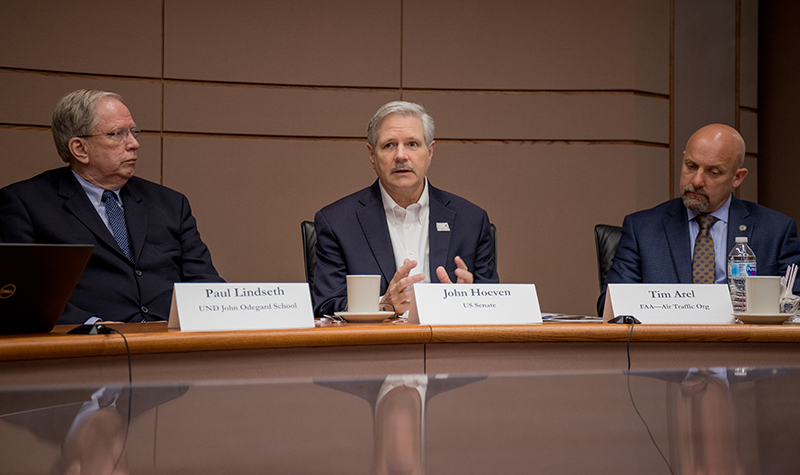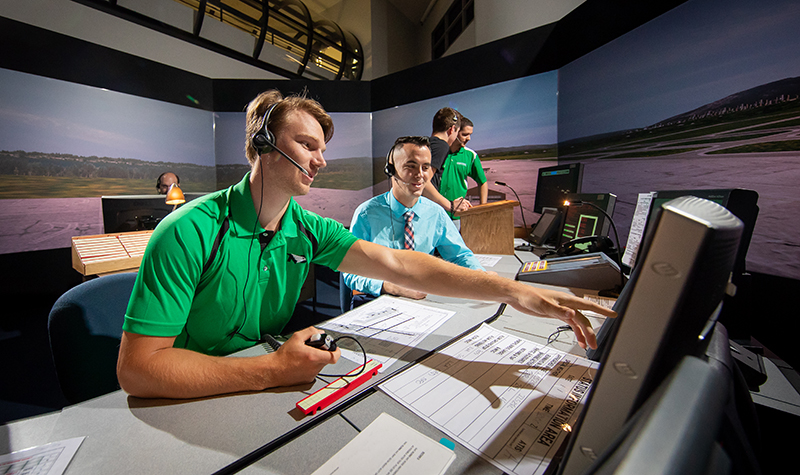25 Apr Hoeven brings FAA to UND to discuss air traffic control hiring regulations

Flanked by Dean of UND Aerospace Paul Lindseth and the Air Traffic Organization’s Deputy Chief Tim Arel, U.S. Sen. John Hoeven, R-N.D., discussed his recent introduction of bipartisan legislation reforming the air traffic controller hiring regulations of the Federal Aviation Administration. Photo by Connor Murphy/UND Today.
Just a month after appearing on campus to announce the return of a legacy flight training program, Sen. John Hoeven, R-N.D., returned to UND, Tuesday, to discuss recently introduced legislation geared toward air traffic management.
The Air Traffic Controller (ATC) Hiring Reform Act of 2019, brought forth by Hoeven and Sen. Jeanne Shaheen, D-N.H., prioritizes the hiring of veterans and graduates of Federal Aviation Administration (FAA)-certified Collegiate Training Initiative (CTI) schools for ATC positions. UND is one of 30 other CTI schools across the nation, including one in Shaheen’s state of New Hampshire.
According to a release from Hoeven, graduates of these schools have a higher retention rate during ATC qualification training at the FAA Academy, in Oklahoma City, where candidates train for positions in air traffic control facilities.
Under current law, the FAA hires from two pools of candidates: CTI graduates and eligible veterans, followed by “off-the-street” candidates applying under vacancy announcements. There can be no more than a 10-percent difference in the number of hires between both pools.
The Hiring Reform Act aims to prefer CTI graduates and veterans in the hiring process – removing the 10-percent limitation to ensure the most qualified candidates are keeping America’s skies and airports safe. The bill also includes reporting requirements for performance of new hires and attrition rates.
“This is better for the government and everyone involved, in terms of time, training and education,” Hoeven said at a roundtable in Odegard Hall, “But it’s also getting the best air traffic controllers in the tower, on the job, which is vital to national security and the safety of the American people.”

UND is home to some of the most advanced air traffic controller training technology available, with two fully interactive simulators and dozens of manned radar stations. Photo by Shawna Schill/UND Today.
Unintended consequences
Paul Drechsel, director of UND’s Air Traffic Management Program, says the FAA hiring changes were made in the beginning of 2014. The FAA introduced a biographical exam that all candidates were required to complete, sorting them into categories.
“Since then, our program numbers dropped,” Drechsel said. The amount of UND students pursuing majors in air traffic management dropped from well over 300 to just 108 in Fall 2018.
At Tuesday’s roundtable, UND’s ATC interests were represented by administrators, faculty and students, hoping to have a career in aviation safety. Deputy Chief of the FAA’s Air Traffic Organization (ATO), Tim Arel, sat next to Hoeven in hearing the concerns of the nation’s leading flight school.
“We’ve all seen a similar drop-off in demand from students,” Associate Dean Beth Bjerke told the senator, referring to other accredited schools nationwide. “It concerns me as a pilot, because I want well-qualified controllers managing air traffic. It’s something we’ve closely monitored for a number of years.”
While waiting on background checks, medical exams and other paperwork creates delays for graduates, many students end up waiting over a year for a chance to undergo FAA indoctrination.
Hoeven says UND’s aviation administrators were the first group to bring the consequences of hiring changes to his attention.
“Under this current program, we’re restricted from getting the best and the brightest, and the best training, into the program,” the senator said. “If the FAA is going to have a system where they work with schools across the country who have a proficiency in aviation and set up the CTI, a pipeline of students who are committed to air traffic control, how can you restrict how many of them get in? I understand there are often good intentions, but good intentions have unintended consequences.”
Hoeven followed by saying the bill has taken some time to come about because he wanted to introduce it on a bipartisan basis, something that can help the bill make its way through Congress.

Tim Arel, a leader of the FAA’s Air Traffic Organization, took part in the roundtable discussion to hear concerns from UND’s administrators, faculty and students. He says the FAA has been meeting hiring quotas through current regulations, but there’s a lack of information when it comes to CTI candidates versus “off-the-street” vacancy applicants. Photo by Connor Murphy/UND Today.
Underlying issues
Arel, after listening to Hoeven’s outlining of the issue at-hand, expressed understanding toward the frustration, but said not all air traffic-CTI schools are equal. For example, UND offers a full four-year bachelor’s degree in Air Traffic Management, which includes nearly 200 hours of hands-on simulator usage. Other CTI schools may just offer a few academic courses with no use of simulation.
Less than 50 percent of CTI students score in the top two tiers of the entrance exam, known as well-qualified and best-qualified.
“To the senator’s point, we want the best and qualified,” Arel said. “We appreciate everyone’s interest and we want to keep that interest. We’ve done a good job of meeting or exceeding our hiring goal over the past few years.”
Arel says unless students perform exceedingly well on the entrance exam, they have a difficult time progressing through the academy. The Oklahoma City academy serves both as a screening and training facility, determining if candidates have the characteristics to be good air traffic controllers.
“They are things that don’t come naturally to our population,” Arel said. “Anything you can do to work on your quick decision-making, analysis and assessment, then execute and move on – that type of skill set will serve you well later on.”
Part of the problem under current regulation is a lack of information regarding CTI versus “off-the-street” hires, as far as success on the job, Arel says. Though, UND’s heavy focus on simulation and leveraging technology puts them ahead of many CTI programs.
“We just want access on merit,” Hoeven responded. “Who can be against that?”
“I don’t think anybody would be,” Arel replied.

Hoeven and company walked over to Clifford Hall following their meeting to see the 360-degree air traffic control tower simulation system in action. Photo by Connor Murphy/UND Today.
Cutting-edge learning
Though Hoeven and Arel were able to see the 360-degree tower simulation system in action, in Clifford Hall, Drechsel says it would have been impactful to see the 32 radar positions that were more than likely full of students as finals week approaches. UND also has another tower simulator, with a 225-degree view, putting UND ahead of most CTI schools, with regard to available technology.

Paul Drechsel
“He appreciates the amount of technology down to the point where he said our touch screens were exactly the same that the FAA uses,” Drechsel said of the ATO deputy chief. “He wants to hire successful, professional graduates that will make a career in the FAA and save them money, as opposed to hiring someone who isn’t sure about what they want to do.”
By Drechsel’s view, the legislation going through would reduce the long stretches students go through while waiting for FAA training. In the past, UND students have been able to bypass the first five weeks of training, given their simulator experience.
After 20 years of Air Force ATC experience, and working at UND for 20 years with the FAA and ATC working groups, Drechsel says UND is the best at what it does.
“It all comes from our leadership,” he said. “The leadership in the college is phenomenal, and without that or the support from campus and the Aerospace Foundation, we wouldn’t have these resources.”
“Our biggest challenge right now is telling the 18 or 19-year-old that this college degree matters,” Bjerke said. “It will make them a well-rounded aviation professional and they’ll do much better at the academy than people hired off the street with three years of work experience.”
Arel says he has no doubts about the value of UND’s degree.


